
Luxury X AI:
How Brunello Cucinelli Masters Technology to Preserve Craftsmanship?
Luxury X AI:
How Brunello Cucinelli Masters Technology to Preserve Craftsmanship?
Explores AI investment trends, Brunello Cucinelli’s application practices, and a strategic roadmap for luxury AI, offering innovation pathways and optimization solutions for the industry.
The global push for AI commercialization shows no signs of slowing in 2024, with luxury brands eagerly entering the arena. However, the delicate balance between preserving brand heritage and embracing technological innovation raises a critical question: how can brands enhance customer value and drive revenue growth without compromising their essence?
Brunello Cucinelli provides an elegant solution—a seamless fusion of technology and craftsmanship.
AI’s relentless evolution continues to be driven by capital investment. From multimodal systems to AI agents and embodied intelligence, 2024 has witnessed technology mature at an unprecedented pace. As these foundational advancements unfold, AI remains a top strategic priority for executive teams, powering enterprise transformation initiatives designed to boost revenue and optimize profitability.
AI is no longer just a peripheral tool; it has evolved into a central, strategic force reshaping industries. Even in the luxury sector, traditionally cautious in embracing emerging technologies, brands are now starting to explore AI’s potential.
The relationship between AI and luxury is not adversarial—it represents an opportunity. The true challenge lies in integrating AI thoughtfully, enhancing brand craftsmanship saliency, while preserving the authenticity and exclusivity of customer experiences. For luxury brands, where strategic decisions typically follow a clear and linear path, AI can either pose a disruptive risk or serve as a transformative lever for growth.
Building on in-depth research, frontline consulting practices, and executive insights, Premier aims to highlight three key dimensions:
1. AI investment trends and forecasts within the luxury sector
2. A case study on Brunello Cucinelli’s AI implementation
3. A tailored AI roadmap for luxury companies

SECTION 1
Commit to Experimentation, Plan with Precision
Observations and Forecast on AI Investment in the Luxury Sector
The luxury industry, traditionally cautious in the face of technological disruptions, has approached AI adoption with a careful, measured pace.
Amid the subdued economic climate of 2024, Premier forecasts that the global luxury market will grow at a compound annual growth rate (CAGR) of 5.9% through 2028 [Exhibit 1]. Within this market, the ultra-luxury segment, including giants like LVMH, Hermès, and Chanel, is particularly under pressure to sustain growth.
However, AI investment in the sector presents a contrasting picture. Research by GlobalData shows that total AI investment in luxury surpassed $360 million over the past three years, representing a 79% year-on-year increase compared to the previous three-year period. Premier estimates that, from 2024 to 2028, global luxury companies will maintain a CAGR of approximately 12.7% in AI-related spending, reaching $2.7 billion by 2028 [Exhibit 2], or 0.1% of the projected luxury market size.
This dual approach—accelerating investment while maintaining cautious strategy—characterizes the luxury sector’s attitude toward technological transformation. The industry’s robust cash flows have supported consistent activity in capital markets, and despite financial challenges and organizational disruptions faced by many companies, strategic AI investments have remained steady.
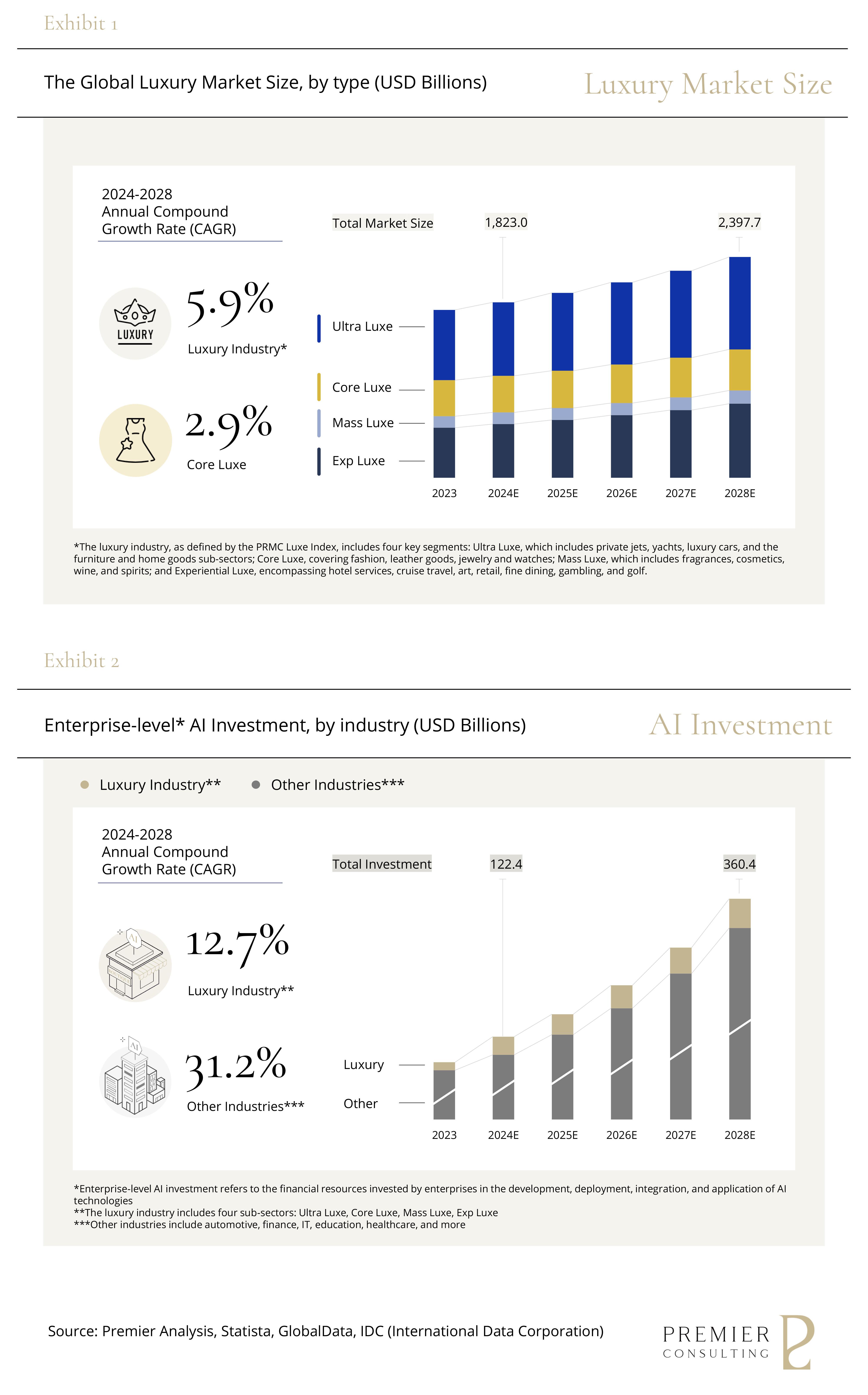
As expected, luxury companies are more cautious in adopting AI compared to other industries. According to this year's AI deployment research [Exhibit 3], the average number of AI use cases among luxury companies is only 1.7, significantly lower than the average of nearly 3 use cases in other industries. Additionally, nearly one-third of luxury companies have yet to implement AI for commercial purposes.
The relatively delayed adoption of digital technologies in the luxury sector can be attributed to the varying deployment of AI across key use cases, where luxury companies outperform other industries in marketing, sales, and customer management. Specifically:
- Marketing content generation, widely deployed but often still in the proof-of-concept stage. Generative AI’s capacity to produce high-quality, customized content remains under scrutiny.
- Sales lead management, typically integrated with existing sales training systems, requiring long-term planning for customer asset utilization and stronger organizational alignment.
- Personalized marketing and customer segmentation, essential tools for connecting with customers, are increasingly adopted by large luxury groups as predictive AI capabilities mature.
- Product development and design, where AI supports creative processes like sample production and prototype visualization. However, concerns around intellectual property and compliance hinder broader adoption.
- Supply chain, logistics management and store operations, which demand extensive data integration and process transformation, remain relatively conservative areas of AI application.
- Knowledge management and smart office tools focus on enhancing employee training and operational efficiency, freeing staff to concentrate on critical tasks.
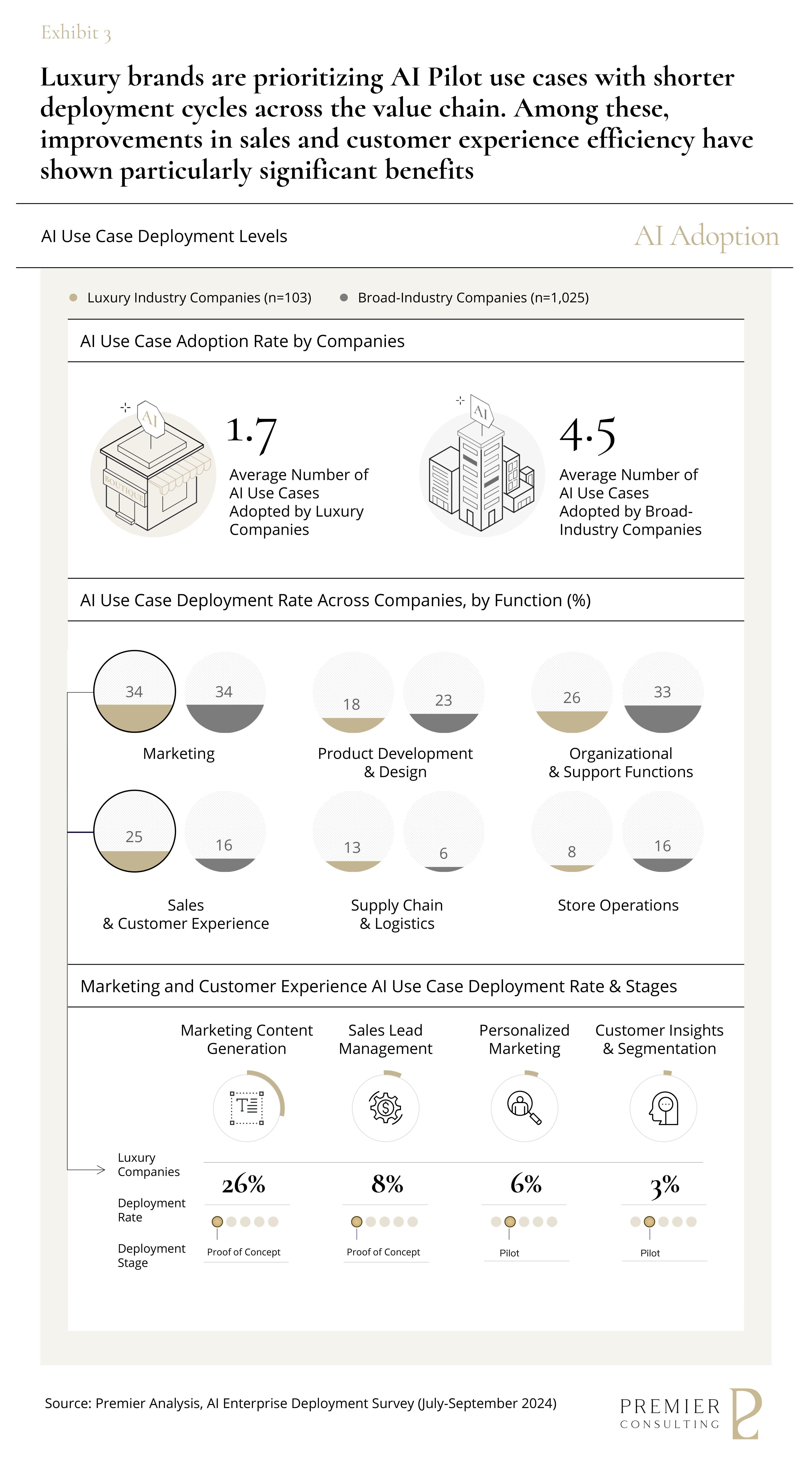
Ongoing investment in AI has become a crucial driver for luxury companies to enhance operational efficiency and refine management practices. At its core, this strategic focus addresses a broader need: navigating the "cost reduction and efficiency improvement" agenda, a challenge all industries face during economic downturns.
In recent years, luxury brands have accelerated the integration of AI throughout their value chains, reflecting their strong ambitions for revenue growth and improved operational efficiency. In evaluating cost inputs against expected returns, companies often prioritize areas of the value chain with shorter deployment cycles, using these as pilot projects for initial AI implementation. Notably, companies of various sizes and organizational structures (single-brand operations versus multi-brand portfolios) exhibit distinct priorities in their AI strategies [Exhibit 4].
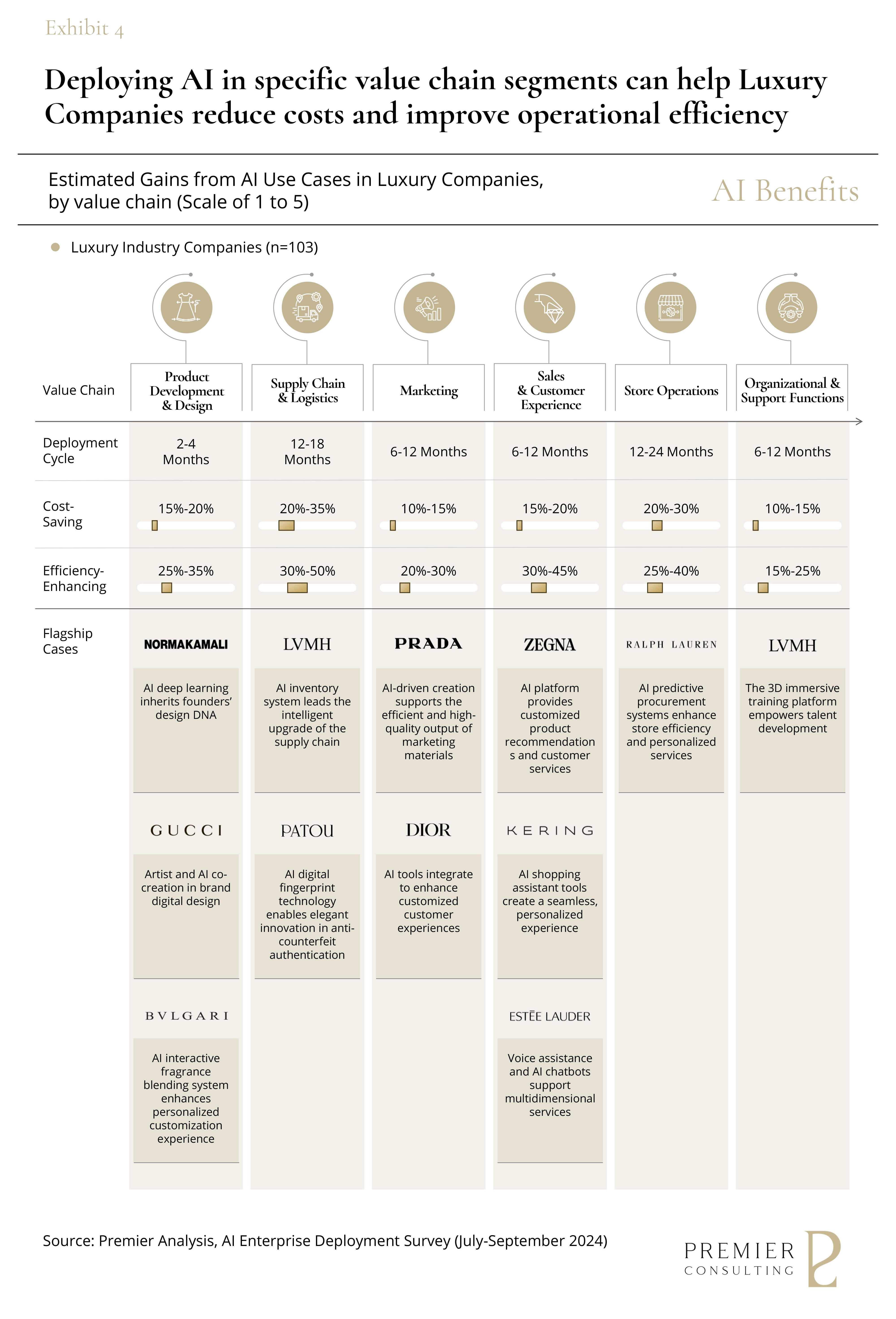
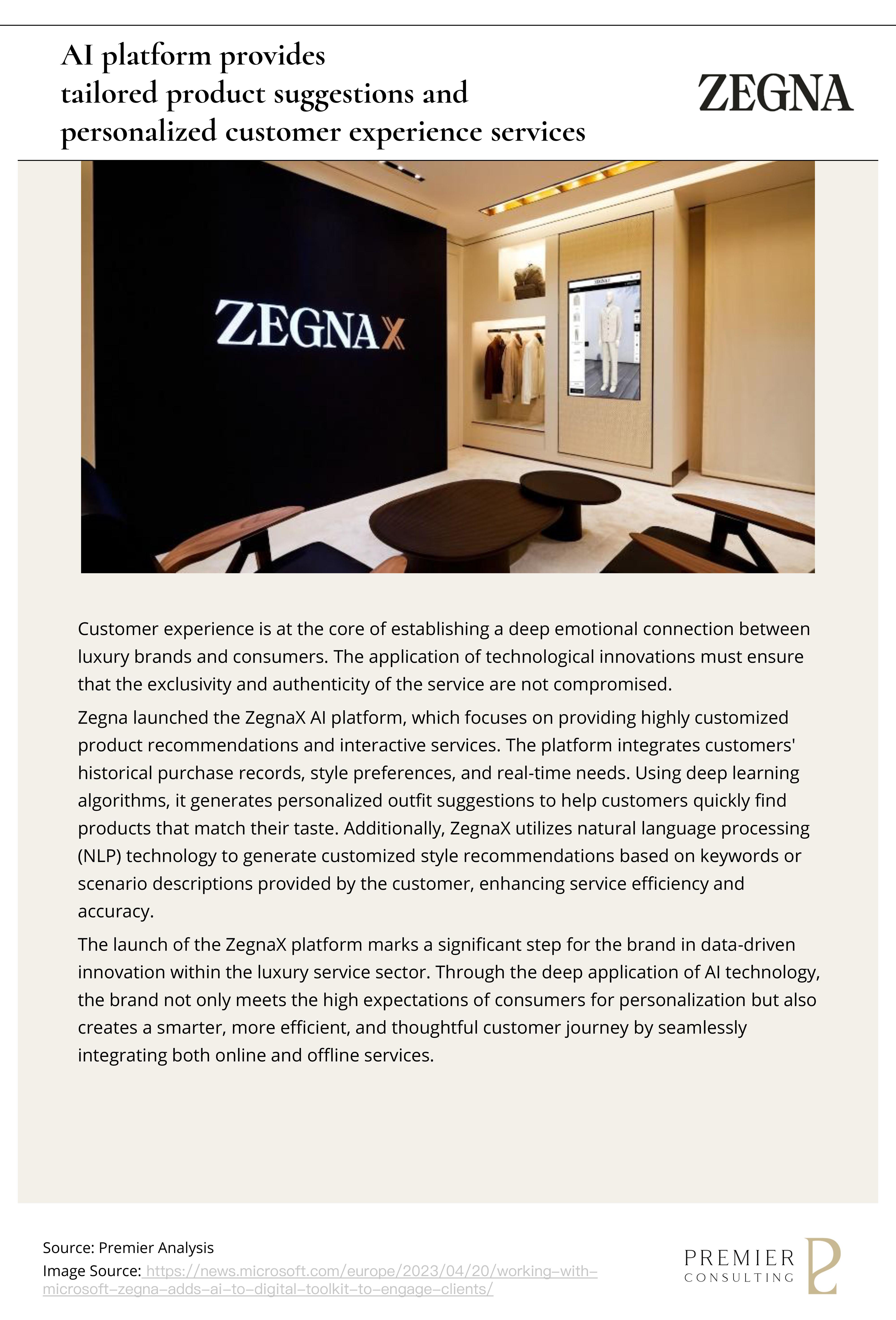
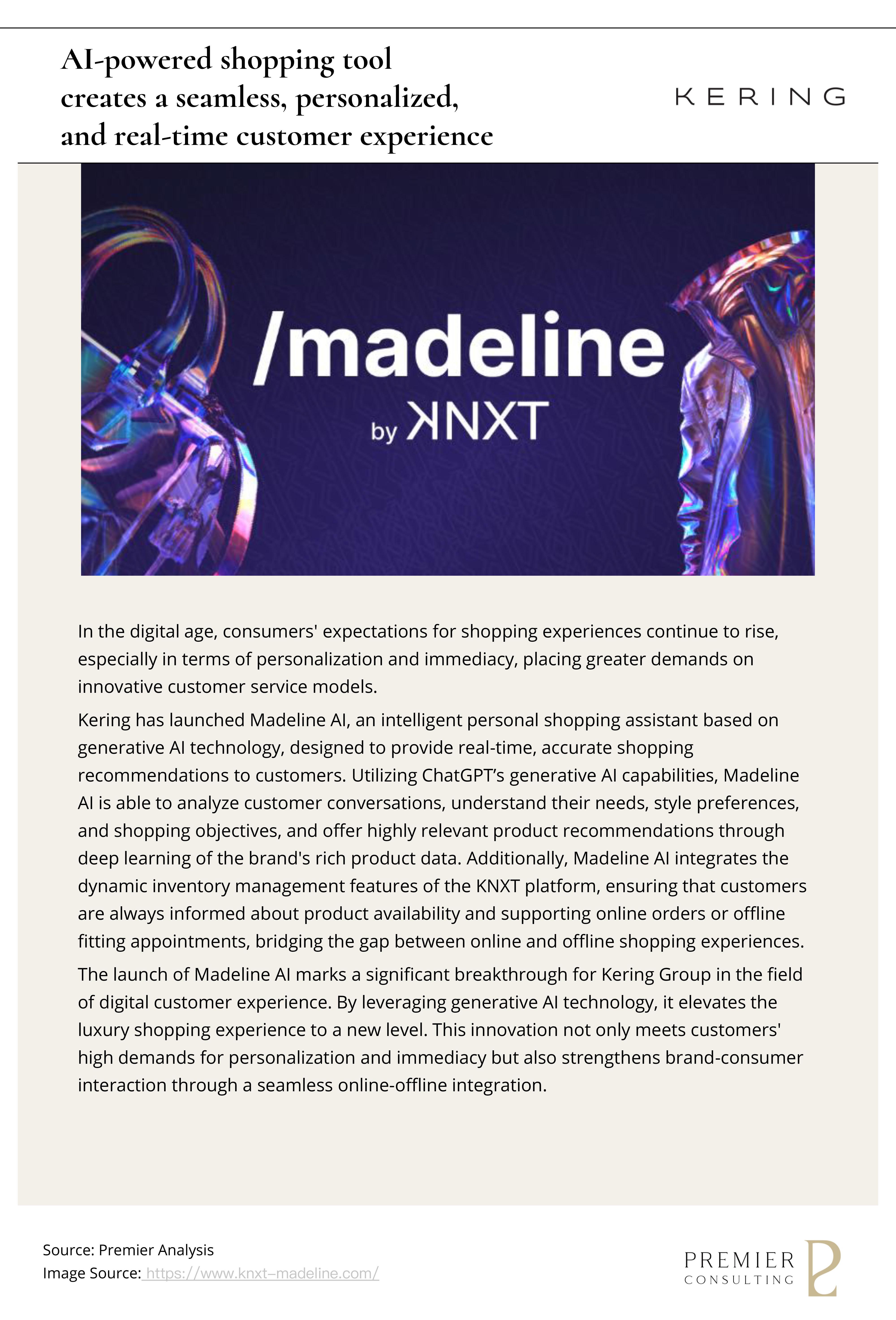
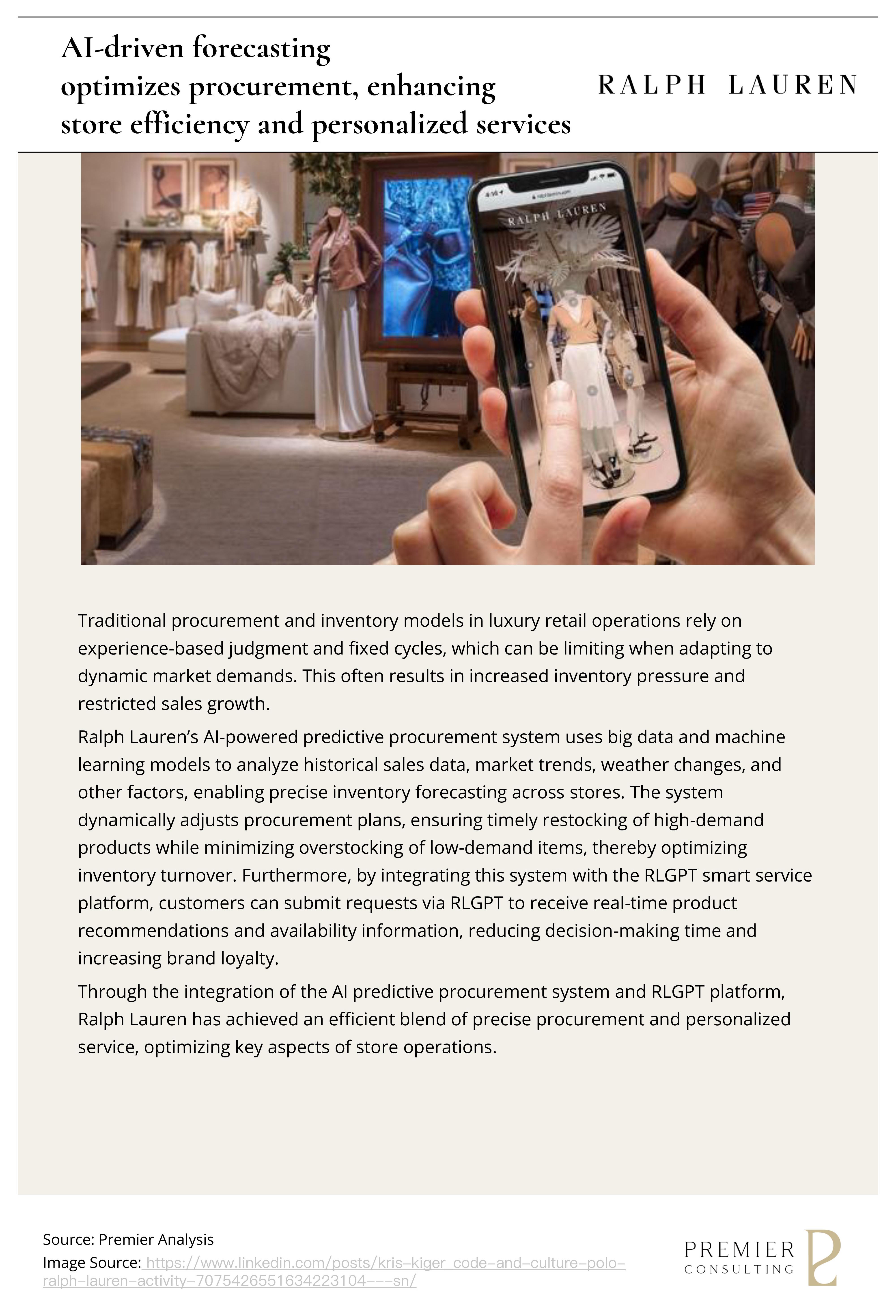
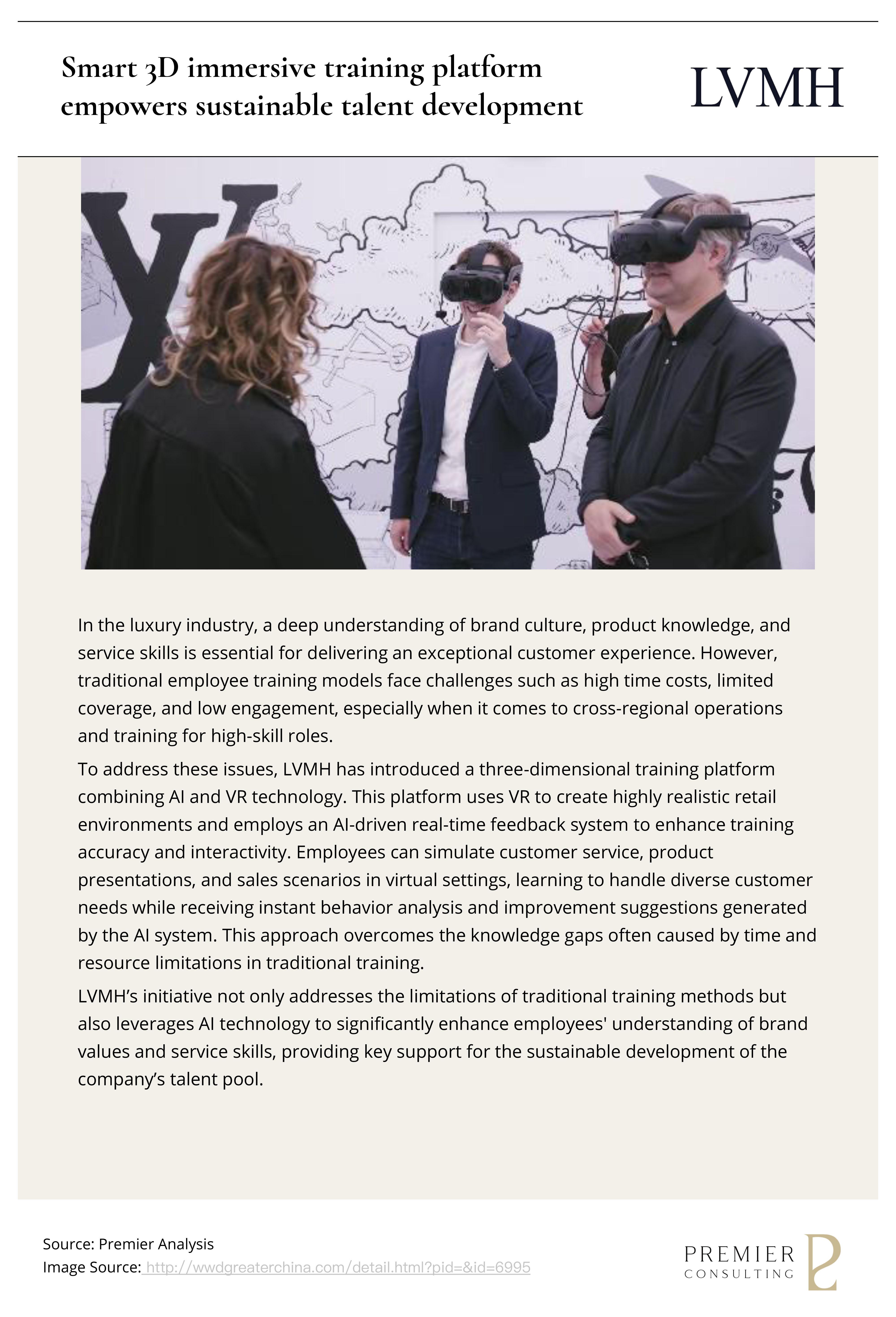
Across various initiatives, two overarching strategic goals consistently emerge as key priorities for AI adoption in the luxury sector:
- Enhancing customer value and strengthening brand connections to drive both immediate and long-term consumption growth.
- Improving operational and production efficiency to mitigate margin pressures from inflation and economic uncertainty.
However, the tangible benefits of AI deployment are still evolving. For many luxury companies, the impact of AI implementations has yet to be fully validated. Some companies, remaining cautious, may ultimately decide to discontinue adoption after extended observation.

SECTION 2
Where Technology Meets Humanity: Reimagining Brand Heritage
Decoding BrunelloCucinelli.AI’s Practice
On July 16 2023, Brunello Cucinelli unveiled the Solomei AI platform and its first creation, the website BrunelloCucinelli.AI, at the Piccolo Teatro di Milano. This launch marks a bold, innovative approach to integrating AI within the luxury sector.
Departing from traditional menus and content layouts, BrunelloCucinelli.AI features a dynamic, zoomable line-drawing background with a single prompt: "What would you like to know?" Serving as the brand’s narrative hub, the site delivers personalized, intelligent responses powered by Solomei AI technology, based on user-initiated queries.
As responses are generated, related content modules appear fluidly, enhanced by elegant, minimalist hand-drawn illustrations. This immersive design provides a highly personalized brand experience. Users can scroll upward to revisit the full conversation history, creating a seamless and engaging narrative flow.
Core themes, including the company's values, mission, brand vision, history, and the founder’s life story, are intricately woven into the responses and content suggestions. This encourages users to explore naturally, deepening their emotional connection with the brand.

At its heart, BrunelloCucinelli.AI is powered by the Solomei AI platform, which organizes web content fluidly in real-time based on user interactions. This innovation transforms website design and navigation, offering a personalized and fresh digital experience.
The platform was developed by a multidisciplinary team of AI experts, led by Reid Hoffman, a prominent figure in tech and venture capital. It took three years to bring its first project, BrunelloCucinelli.AI, to life.
The name "Solomei" is inspired by the company’s headquarters in Solomeo, Italy. The platform’s core components draw from Greek philosophers, poets, scholars, and mythological figures, reflecting characteristics that align with the platform’s technological features. This blend of humanistic elegance and technical sophistication mirrors the brand’s commitment to detail.

Every element of the platform—ranging from narrative content and dynamic interactions to multimedia assets and illustrations—aligns seamlessly with Brunello Cucinelli’s brand ethos. Users are immersed in a digital landscape where simplicity, elegance, and humanistic art intersect.
This fusion of luxury branding and artificial intelligence not only pushes the boundaries of creativity in the luxury sector but also redefines brand heritage. It demonstrates how technology can elevate, rather than dilute, the authenticity and legacy of a luxury brand.
Brunello Cucinelli: Why Is the Brand Betting on Artificial Intelligence?
Undoubtedly, this strategic move is supported by the company’s strong financial performance, providing the necessary momentum to aim for even greater results.
Despite a global slowdown in luxury goods market demand, Brunello Cucinelli has demonstrated consistent growth. In the third quarter of 2024, global revenues rose by 9.2% year-on-year, reaching €300 million. For the first nine months of the year ending on September 30, revenues grew by 12.4%, totaling €920.2 million [Exhibit 5].
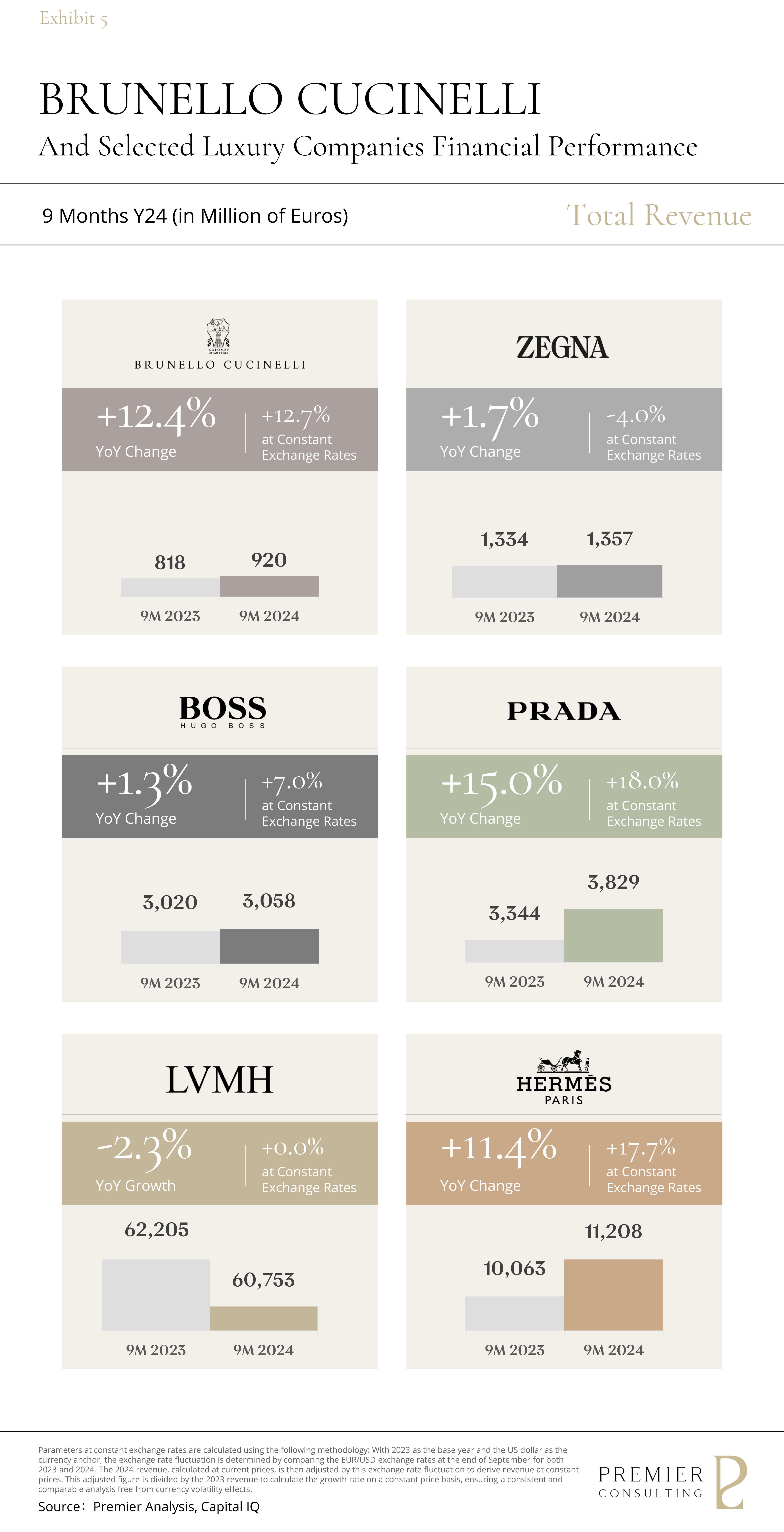
Amidst challenges in the Chinese market, the brand has continued to deliver strong performance, reporting double-digit growth in the third quarter [Exhibit 6]. The company has maintained its full-year revenue growth forecast at around 10% and expects this positive trend to persist into 2025 and 2026. Founder and Executive Chairman Brunello Cucinelli emphasized that customer trust in the brand’s dedication to exceptional craftsmanship is the key driver of its success, with a generally optimistic outlook for the future.
Reviewing the half-year financial report, the brand’s profitability underscores its robust growth across multiple dimensions. Operating profit increased by 19.3% year-on-year, reaching €104.6 million, with the operating profit margin rising from 16.1% to 16.9%. Net profit grew by 33.1% year-on-year to €66.1 million, with a net profit margin of 9.8%. Operating cash flow rose by 28.6%, and free cash flow increased by 31.1%, highlighting the company’s strong operational efficiency and cash flow generation.
Additionally, Brunello Cucinelli has made significant investments in the 2024-2025 period, including the expansion of its Solomeo (Italy) factory to support increased production capacity over the next decade. Despite a slight rise in the debt-to-equity ratio to 2.42% (up by 0.19% year-on-year), the company’s prudent use of leverage ensures that the expansion plan progresses within a healthy financial framework.
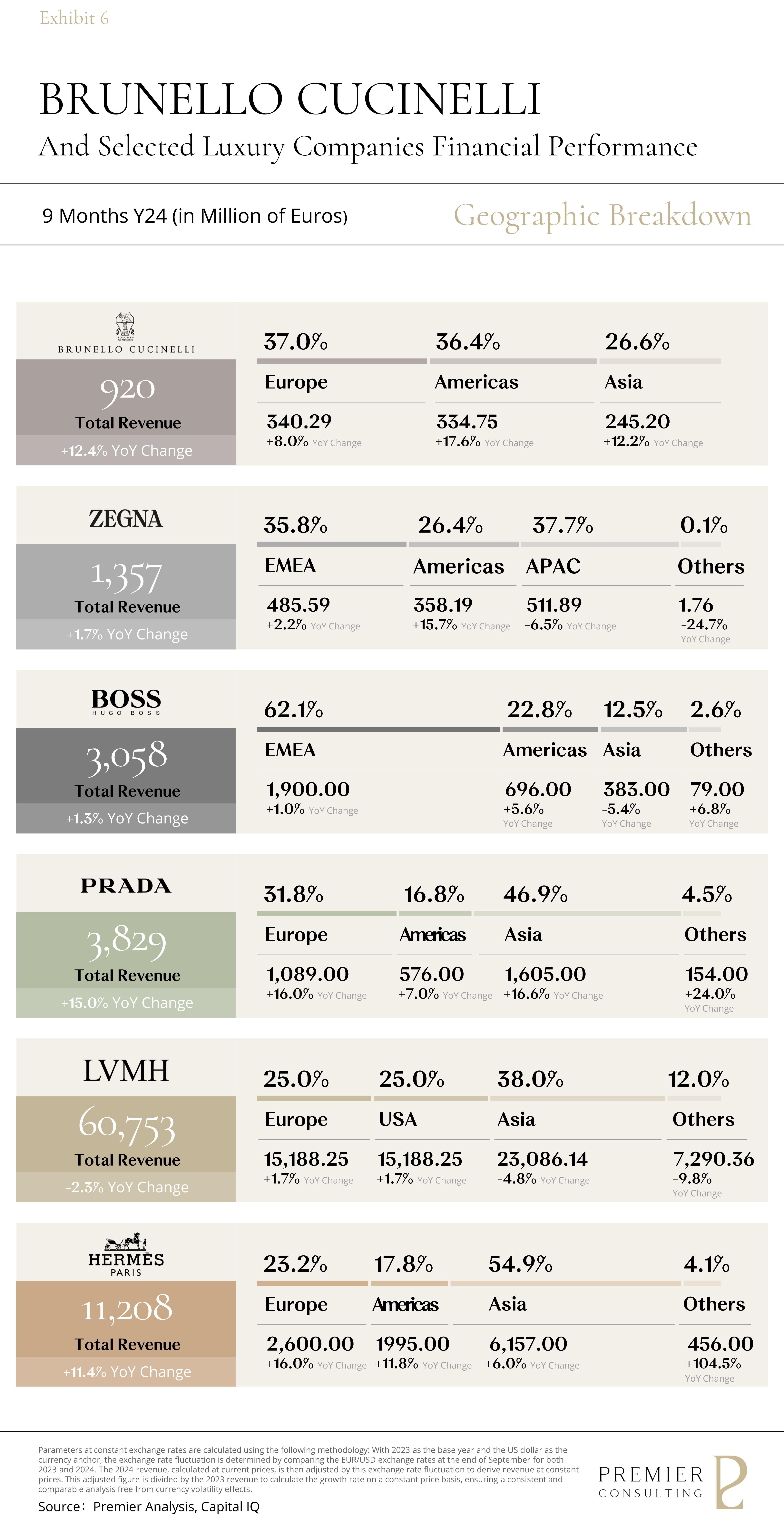
Brunello Cucinelli’s 2024 stock performance underscores the market’s strong conviction in the brand’s financial strength and long-term growth trajectory. As of December 20, 2024, the company’s share price closed at €105.00, representing an 18.51% increase year-to-date and a 21.32% rise over the past 12 months. Amid a broader downturn across the premium luxury index, Cucinelli stood out as a rare outperformer, delivering a standout result in a challenging market environment [Exhibit 7].
Over its 12-year tenure on the Milan Stock Exchange, the company’s market capitalization has soared from approximately €500 million to €7.2 billion—a remarkable ascent that reflects both sustained investor confidence and the enduring appeal of its craftsmanship-driven brand philosophy.
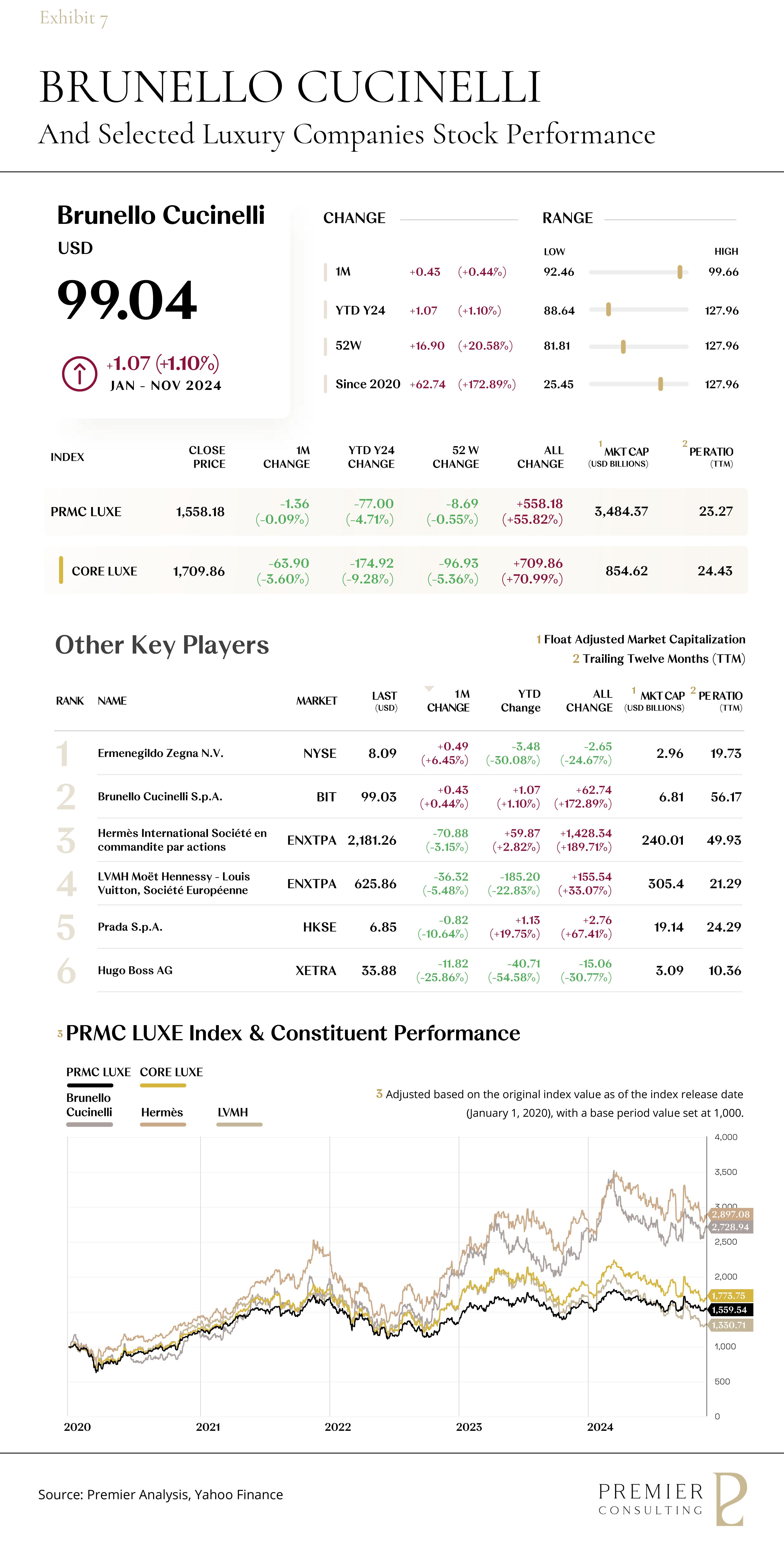
"The next 500 years will be defined by the role artificial intelligence plays in this century," remarked the founder. Cucinelli compares AI to "a new handmaiden that accompanies human beings to inspire and renew their genius and creativity." On a deeper level, he advocates for humanity to embrace AI with hope rather than fear, viewing it as a tool for liberation that alleviates material burdens while fostering harmony between technological progress and human values.
This rational exploration of AI, coupled with his unique humanistic perspective, stems from Cucinelli’s dual role as both the head of an Italian luxury brand and a philosopher. His philosophy, "Humanistic Capitalism," advocates for companies to pursue profits ethically and with dignity, while maintaining a deep respect for humanity and the environment. This was influenced by his formative experiences in rural Italy, particularly the memory of his grandfather’s tradition of donating the first wheat harvest each year.
As depicted in the illustration, Cucinelli envisions a world where culture, spirit, and environmental sustainability are in balance—a vision that integrates technological innovation with humanism. Since founding his brand at the age of 25, his concept of Humanistic Capitalism has influenced both the company’s culture and management style, while shaping his views on emerging technologies.
In the field of AI, Cucinelli spoke at the first Universal Symposium on Soul and Economics in Italy in 2019, stating that technological progress is not just a reflection of human ability but also a key element in "Making People Human". He has worked with Silicon Valley AI experts to explore the foundations of a harmonious relationship between humanism and technology, emphasizing that technological development must align with human values.
In the summer of 2021, Cucinelli officially formed a multidisciplinary AI team to develop the Solomei AI platform. The team, consisting of two mathematicians, one engineer, one artist, and one philosopher, unveiled their first project, BrunelloCucinelli.AI, after three years of development. This project vividly illustrates the boundless potential of blending humanism with technology.
Looking ahead, Cucinelli plans to integrate AI into e-commerce, offering intelligent outfit recommendations based on user needs on independent shopping platforms. This also signals the company’s broader strategy in personalized clienteling and brand knowledge training.
From a business perspective, Brunello Cucinelli’s approach bridges the gap between traditional corporate capital investment and technology deployment. By developing proprietary AI technology, the brand has created an in-house platform for content display and interaction, setting itself apart as a unique tool for brand storytelling. This innovation also positions the company to effectively integrate AI throughout its value chain, enhancing compatibility and interoperability for future applications.
From a brand perspective, this strategy seamlessly blends AI-driven, personalized customer experiences with the brand's artisan heritage, injecting the dynamic energy of modern technology while preserving its core identity. Rather than diluting the brand's humanistic values, the introduction of AI strengthens its distinctiveness in delivering personalized service and differentiated experiences.
This approach of integrating technology enhances the brand's legacy, achieving a sophisticated balance between cultural heritage and technological innovation—exactly as Cucinelli envisioned.
Solomei, embodying Cucinelli’s philosophy and spiritual aspirations, materializes as Solomei AI, a tangible expression of “Where Human and Artificial Intelligence Meet”. This stands as a testament to the commercial embodiment of humanistic capitalism.
This AI initiative, infused with emotion and conviction, represents a commercial endeavor driven by both subtle intent and a powerful expression of visionary leadership. Traditional performance metrics may fall short in capturing the full value of this innovation. However, it is undeniable that it will become a lasting component of the Brunello Cucinelli brand legacy, enduring at the intersection of the digital world and fine cashmere fibers.

SECTION 3
Leadership Alignment Strategy,
Safeguarding Brand Value and Driving Business Growth
Premier CAPE AInspire | AI Strategy for Luxury Industry
Brunello Cucinelli’s AI strategy offers a pioneering solution for AI deployment in the luxury industry, characterized by its strong brand identity and distinctive implementation approach. Cucinelli’s leadership serves as the cornerstone for the successful execution of AI use cases, steering the company’s initiatives with a clear and forward-thinking vision.
For other luxury brands and broader industry players, navigating the complexities of shifting external market conditions and diverse internal stakeholder interests demands a sophisticated approach to leadership. The ability to align business objectives with technology strategies is a critical challenge when adopting AI innovations, ensuring a sustainable path for development and implementation.
Cucinelli’s philosophy of the "coexistence of human and intelligence" resonates strongly with Premier CAPE AInspire’s solution. Premier’s "Human-centered" approach places people at the core of its AI deployment strategy, prioritizing the seamless integration of technology with human values. This ensures that AI initiatives are not only innovative but also meaningful and inclusive within the organization.
Tailored to the luxury industry’s focus on brand values, Premier’s CAPE AInspire solution breaks down leadership alignment into three strategic pillars: consistency in business strategy, alignment with customer strategy, and technological coherence. By optimizing implementation and integrating AI tools for direct impact, Premier helps businesses preserve their brand legacy while exploring technology-driven growth. This approach nurtures a balanced, symbiotic relationship between people, brand, and innovation.
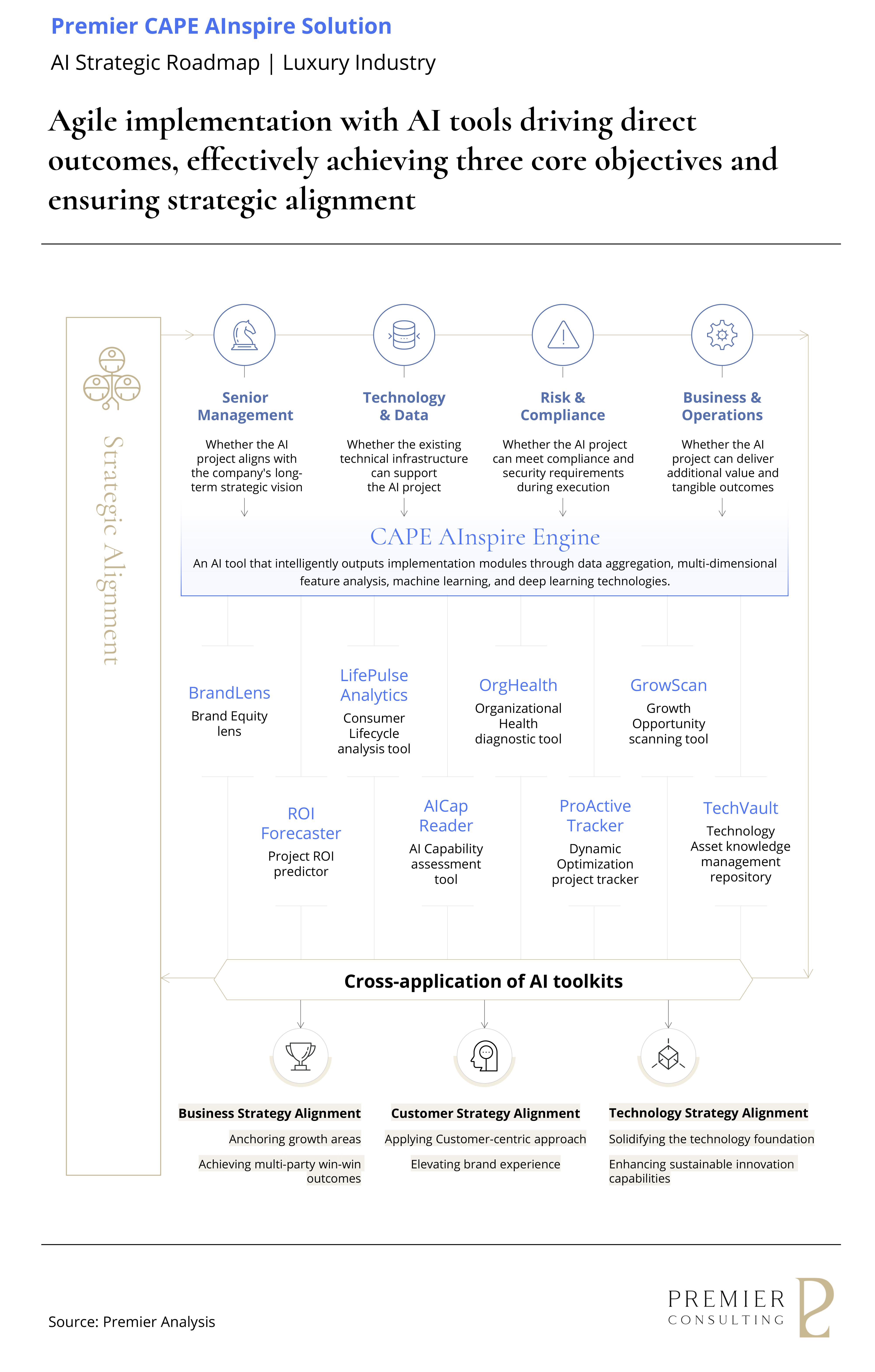
Business Strategy Alignment:
Driving Growth Areas for Multi-Stakeholder Win-Win Outcomes
Focused on achieving business growth and addressing stakeholder needs, we ensure precise alignment and efficient execution of strategic initiatives:
- Stakeholder Identification and Alignment: Leveraging OrgHealth, we conduct comprehensive analyses of internal stakeholders' needs and organizational fit, ensuring that the business strategy aligns with diverse stakeholder interests.
- Identifying Growth Opportunities: Through the GrowScan tool, we gain valuable insights into business growth potential and critical development areas, empowering management with data-driven decision-making.
- Quantifying Project ROI: With the ROI Forecaster, we provide scientific predictions of project returns, enabling management to balance short-term profitability with long-term growth goals.
- Dynamic Tracking and Execution Optimization: Leveraging the ProActive Tracker, we monitor and optimize project execution in real time, ensuring effective strategy implementation and responsiveness to shifting stakeholder needs.
Customer Strategy Alignment:
Elevating the Brand Experience with a Customer-Centric Approach
Focused on customer needs and experiences, this strategy ensures that AI deployment is closely aligned with brand values, fostering relevant and inclusive customer engagements:
- Brand Equity Review: Using the BrandLens framework, we conduct a comprehensive evaluation of current brand equity and market performance, ensuring that core brand values are preserved and enhanced through AI applications.
- Holistic Consumer Insights: Leveraging LifePulse Analytics, we gain deep insights into customer lifecycle dynamics and behavioral trends, enabling the redesign of the customer journey to enhance personalized, exclusive experiences.
- Technology Fit Assessment: With the AICap Reader tool, we assess the alignment between technology and customer strategy, ensuring that technological applications effectively meet customer needs.
Technology Strategy Alignment:
Strengthening the Technological Foundation to Enhance Sustainable Innovation Capabilities
Focusing on technology deployment and organizational alignment, this strategy aims to eliminate technology alienation, ensuring precise integration with business objectives for sustainable application:
- Organizational Operations and Technology Readiness Assessment: Using the OrgHealth diagnostic tool, we assess operational efficiency and team readiness to ensure that technology deployment is closely aligned with business goals.
- AI Maturity and Capability Assessment: Leveraging the AICap Reader tool, we evaluate the maturity and readiness of AI technologies, providing a solid foundation for businesses to progressively integrate technology.
- Technology Asset Management and Continuous Optimization: Through the TechVault platform, we centralize and optimize technology resources, enabling efficient allocation and continuous upgrading of technological assets to support long-term organizational evolution.
Navigating the Boundaries Towards Collaborative AI Development
The implementation of human-centric AI goes beyond successful technology deployment; it requires deep integration into corporate culture and ecosystem, establishing an innovation-driven framework for long-term development.
Premier facilitates this integration through four key modules: empowering interconnected frameworks, upholding responsibility in AI principles, managing change, and ensuring continuous optimization. These modules are supported by tailored internal communication channels and formats—including AI practice guides, curated journals, thematic workshops, pilot project sharing sessions, use case requirement linkage platforms, and tools & skills training courses—creating a practical and effective framework for AI application. This ensures synergy between technology and the organization, fostering a truly symbiotic AI ecosystem where both people and technology evolve together.
In today’s economically uncertain environment, strategically deploying AI within structured boundary frameworks highlights its flexibility and sustainability. Through our work with elite industry clients, we have observed that this approach strengthens their long-term competitive edge and ensures robust development amid the waves of technological innovation.
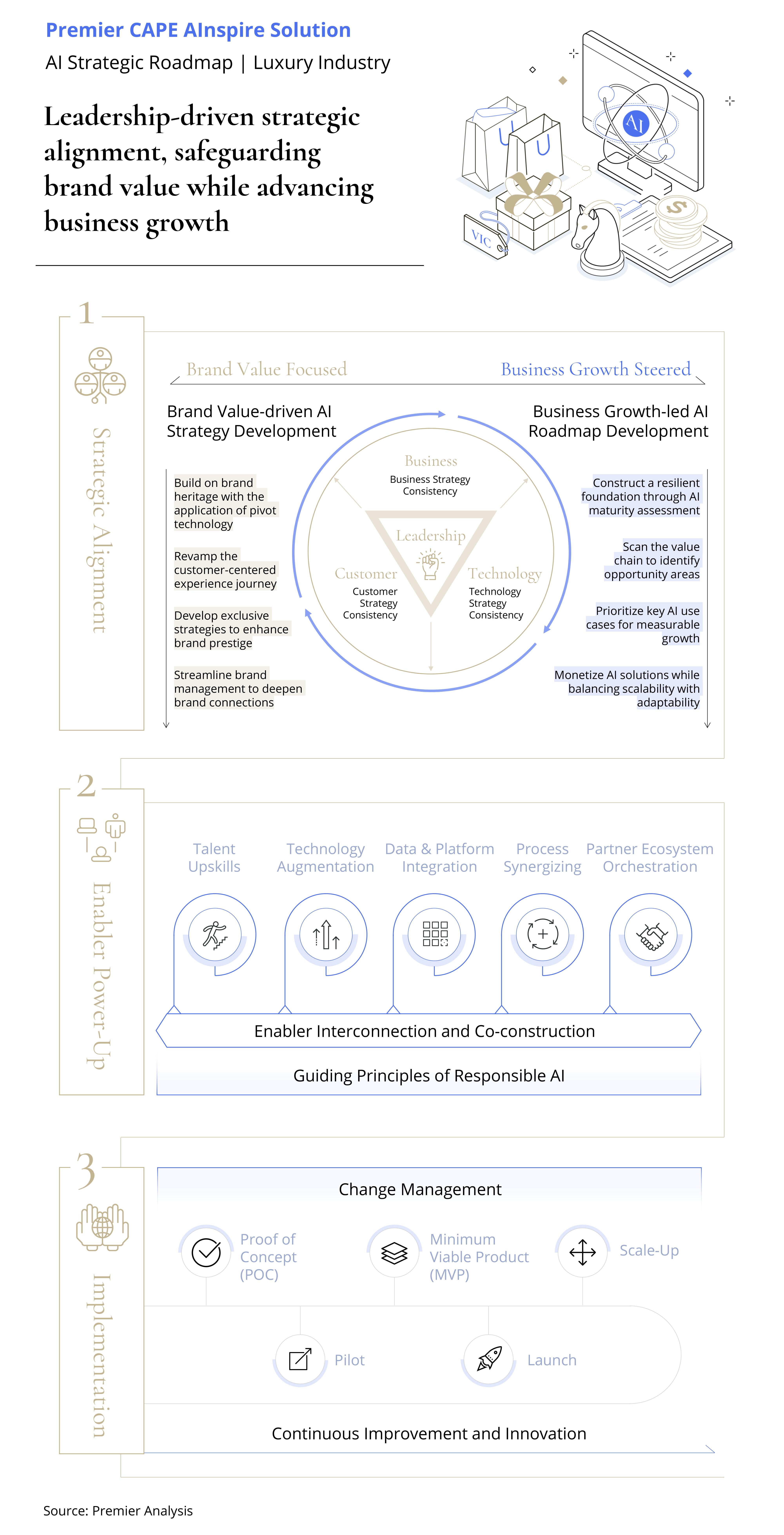

SECTION 4
Closing Remarks
The luxury industry is unique in its complexity. For luxury brands, our goal is to apply a strategic lens that seamlessly blends the power of artificial intelligence with traditional craftsmanship. This approach not only preserves brand value but also unlocks growth opportunities driven by technology.
With the flexible leadership of people and the structured support of tools, AI transitions from a disruptive force into a medium that sustains brand narratives, enhances customer experiences, and fosters sustainable innovation.
Brunello Cucinelli has demonstrated that technology can be soft, like the delicate touch of fine wool against the skin, telling the story of human civilization’s evolution and inspiring grand dreams. At the same time, AI can be warm, like the skilled hands of a craftsman, weaving connections between humanity and the world, extending imagination and emotional ties.
In 2025, AI development will progress in alignment with this trend. Brunello Cucinelli, as a leader in the integration of technology and craftsmanship, stands watchful, quietly witnessing the emergence of future technological assets, while narrating the ambitious story of a century-old brand’s legacy.

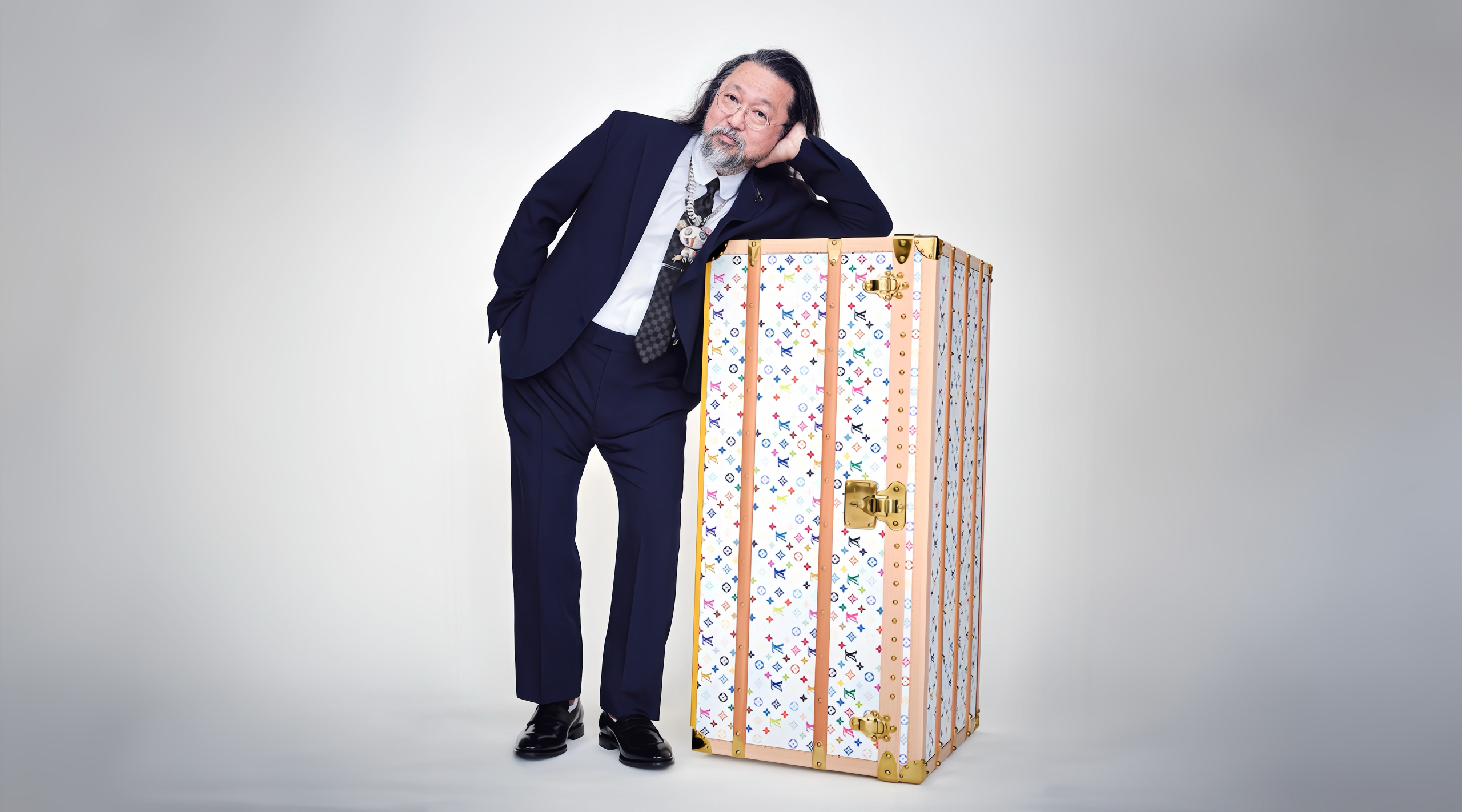
A New Chapter in Experiential Luxury Business

Luxury X AI:
How Brunello Cucinelli Masters Technology to Preserve Craftsmanship?
Dec 18, 2025
Explores AI investment trends, Brunello Cucinelli’s application practices, and a strategic roadmap for luxury AI, offering innovation pathways and optimization solutions for the industry.
The global push for AI commercialization shows no signs of slowing in 2024, with luxury brands eagerly entering the arena. However, the delicate balance between preserving brand heritage and embracing technological innovation raises a critical question: how can brands enhance customer value and drive revenue growth without compromising their essence?
Brunello Cucinelli provides an elegant solution—a seamless fusion of technology and craftsmanship.
AI’s relentless evolution continues to be driven by capital investment. From multimodal systems to AI agents and embodied intelligence, 2024 has witnessed technology mature at an unprecedented pace. As these foundational advancements unfold, AI remains a top strategic priority for executive teams, powering enterprise transformation initiatives designed to boost revenue and optimize profitability.
AI is no longer just a peripheral tool; it has evolved into a central, strategic force reshaping industries. Even in the luxury sector, traditionally cautious in embracing emerging technologies, brands are now starting to explore AI’s potential.
The relationship between AI and luxury is not adversarial—it represents an opportunity. The true challenge lies in integrating AI thoughtfully, enhancing brand craftsmanship saliency, while preserving the authenticity and exclusivity of customer experiences. For luxury brands, where strategic decisions typically follow a clear and linear path, AI can either pose a disruptive risk or serve as a transformative lever for growth.
Building on in-depth research, frontline consulting practices, and executive insights, Premier aims to highlight three key dimensions:
1. AI investment trends and forecasts within the luxury sector
2. A case study on Brunello Cucinelli’s AI implementation
3. A tailored AI roadmap for luxury companies





